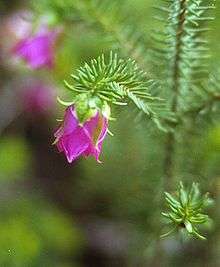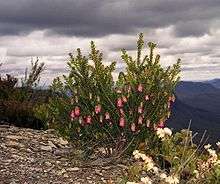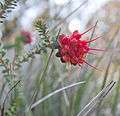Darwinia (plant)
| Darwinia | |
|---|---|
 | |
| Darwinia leiostyla | |
| Scientific classification | |
| Kingdom: | Plantae |
| (unranked): | Angiosperms |
| (unranked): | Eudicots |
| (unranked): | Rosids |
| Order: | Myrtales |
| Family: | Myrtaceae |
| Tribe: | Chamelaucieae |
| Genus: | Darwinia Rudge |
| Species | |
|
See text. | |
| Synonyms[1] | |
| |
Darwinia, sometimes commonly known as mountain bells or simply bells, is a genus of about 70 species of evergreen shrubs in the family Myrtaceae, endemic to southeastern and southwestern Australia. The majority are native to southern Western Australia, but a few species occur in South Australia, New South Wales and Victoria. The genus was named in honour of Erasmus Darwin, grandfather of Charles Darwin by Edward Rudge in 1816. Most darwinias grow to a height of between 0.2 and 3 m (0.7 and 10 ft) and many are prostrate shrubs. Most have small, simple leaves and the flowers are often grouped together, each flower with five red, white or greenish petals and ten stamens. In many species, the flowers are surrounded by large, colourful bracts, giving rise to their common names.
Description
Darwinia species are prostrate to erect, woody shrubs growing to a height of 0.2 and 3 m (0.7 and 10 ft). The leaves are usually arranged in opposite pairs and are simple, small, needle-like to oval and contain essential oils. The flowers are arranged near the ends of the branches and are usually surrounded by leaf-like green bracts and larger, usually coloured bracteoles. The flowers have five, usually very small sepals and 5 petals which enclose the stamens and may be white or coloured. There are 10 stamens which alternate with 10 staminodes, all of which are enclosed by the petals so that they are not visible in an intact flower. The style projects beyond the flower and has a groups of hairs near the stigma. The fruit is a non-fleshy nut which retains the (usually one) seed at maturity. [2][3][4]
Taxonomy and naming
The genus Darwinia was first formally described by Edward Rudge in 1816 and the type species is Darwinia fascicularis. Rudge published his description in Transactions of the Linnean Society of London.[5] There are about 70 species but many have not been formally described. George Bentham undertook a review of the genus in 1865 when he described 23 species in Flora Australiensis[6] (although the species he named Darwinia verticordina is now known as Verticordia verticordina).[7] The genus was named for Erasmus Darwin.[8]
About 30 species of Darwinia have been discovered but not yet formally described. They have been given informal names such as Darwinia sp. Bindoon and Darwinia sp. Canna.[9]
Distribution
Darwinias are found in New South Wales, Victoria, South Australia and Western Australia. Sixty of the roughly 70 species occur in Western Australia and 11 grow naturally in New South Wales.[3][10]
Ecology
Land clearing and grazing practices have reduced the areas where Darwinia species grow naturally. Recovery is hindered by drought, changed fire regimes and susceptibility of some species, especially Gillam's Bell (Darwinia oxylepis) to infection by the oomycete Phytophthora cinnamomi.[11]
Conservation
Some species in the genus Darwinia are threatened with extinction, being listed as Endangered or Vulnerable on the Australian National List of Threatened Flora. These include the Yellow Mountain Bell (Darwinia collina), Gillam's Bell (Darwinia oxylepis) and Abba Bell (Darwinia whicherensis).[12]
Use in horticulture
Darwinias are difficult to propagate from seed but can be cultivated from cuttings.[13]
List of species
- Darwinia acerosa – fine-leaved darwinia (endangered)
- Darwinia apiculata – scarp darwinia (endangered)
- Darwinia biflora (vulnerable)
- Darwinia briggsiae
- Darwinia camptostylis - clustered darwinia
- Darwinia capitellata
- Darwinia carnea – Mogumber bell, Narrogin bell (endangered)
- Darwinia chapmaniana – Chapman's bell or Eganu bell (endangered)
- Darwinia citriodora – lemon-scented darwinia
- Darwinia collina – yellow mountain bell (endangered)
- Darwinia diosmoides
- Darwinia diminuta
- Darwinia divisa - (presumed extinct)[14]
- Darwinia fascicularis
- Darwinia ferricola – Scott River darwinia (endangered)
- Darwinia foetida – Muchea bell
- Darwinia glaucophylla (vulnerable)
- Darwinia grandiflora
- Darwinia helichrysoides
- Darwinia homoranthoides
- Darwinia hortiorum
- Darwinia hypericifolia
- Darwinia leiostyla
- Darwinia leptantha
- Darwinia luehmannii
- Darwinia macrostegia – Mondurup bell (vulnerable)
- Darwinia masonii – Mason's barwinia (vulnerable)
- Darwinia meeboldii – Cranbrook bell (vulnerable)
- Darwinia micropetala – small darwinia
- Darwinia neildiana – fringed bell
- Darwinia nubigena – success bell (vulnerable)
- Darwinia oederoides
- Darwinia oldfieldii -
- Darwinia oxylepis – Gillam's bell (endangered)
- Darwinia pauciflora
- Darwinia peduncularis (vulnerable)
- Darwinia pimelioides
- Darwinia pinifolia
- Darwinia polycephala
- Darwinia polychroma – harlequin bell (endangered)
- Darwinia procera
- Darwinia purpurea – rose darwinia
- Darwinia sanguinea
- Darwinia speciosa
- Darwinia squarrosa – pink mountain bell (vulnerable)
- Darwinia taxifolia
- Darwinia terricola
- Darwinia thymoides
- Darwinia vestita – pom-pom darwinia
- Darwinia virescens – Murchison darwinia
- Darwinia whicherensis – Abba bell (endangered)
- Darwinia wittwerorum – Wittwer's mountain bell (endangered)
Gallery
.jpg) Darwinia chapmaniana in Kings Park
Darwinia chapmaniana in Kings Park Darwinia sp. Mt Burdett in Kings Park
Darwinia sp. Mt Burdett in Kings Park Darwinia hypericifolia in Royal Botanic Gardens, Cranbourne
Darwinia hypericifolia in Royal Botanic Gardens, Cranbourne Darwinia leiostyla in the Stirling Range, Western Australia
Darwinia leiostyla in the Stirling Range, Western Australia Darwinia oldfieldii
Darwinia oldfieldii Darwinia taxifolia subsp. macrolaena in Royal Botanic Gardens, Cranbourne
Darwinia taxifolia subsp. macrolaena in Royal Botanic Gardens, Cranbourne.jpg)
References
- ↑ Kew World Checklist of Selected Plant Families
- ↑ "Darwinia". FloraBase. Western Australian Government Department of Parks and Wildlife.
- 1 2 Wilson, Peter G. "Genus Darwinia". Royal Botanic Garden Sydney: PlantNET. Retrieved 7 September 2016.
- ↑ "Darwinia Rudge". eBotany. Retrieved 12 September 2016.
- ↑ "Darwinia". APNI. Retrieved 7 September 2016.
- ↑ Bentham, George (1865). Flora Australiensis. London: Lovell Reeve and Co. pp. 6–15. Retrieved 7 September 2016.
- ↑ "Darwinia verticordina". APNI. Retrieved 7 September 2016.
- ↑ "Darwinia citriodora". Australian National Botanic Garden. Retrieved 7 September 2016.
- ↑ "Darwinia Rudge". Western Australian Herbarium. Retrieved 8 September 2016.
- ↑ Keighery, G.J. (2009). "Six new and rare species of Darwinia (Myrtaceae) from Western Australia" (PDF). Nuytsia. 19 (1): 37–52. Retrieved 2009-07-24.
- ↑ "Conservation Advice Darwinia oxylepis" (PDF). Australian Government Department of the Environment. Retrieved 8 September 2016.
- ↑ "EPBC Act List of Threatened Flora". Australian Government Department of the Environment. Retrieved 8 September 2016.
- ↑ "Darwinia meeboldii". Australian Native Plants Society (Australia). Retrieved 8 September 2016.
- ↑ Gibson, Neil (2016). "Western Australian plant taxa not collected for more than 50 years". Nuytsia. 27: 151–152.
External links
| Wikimedia Commons has media related to Darwinia. |